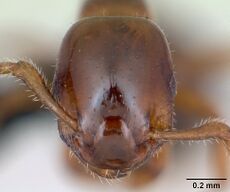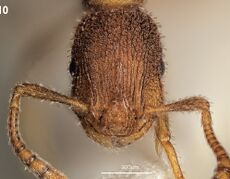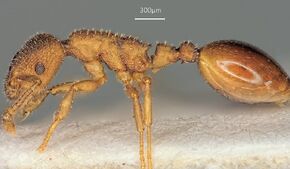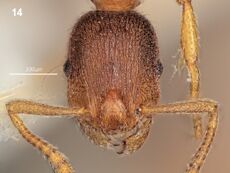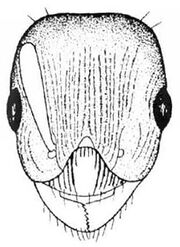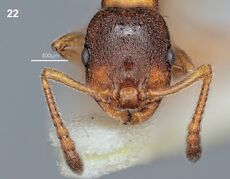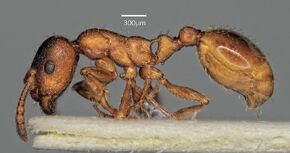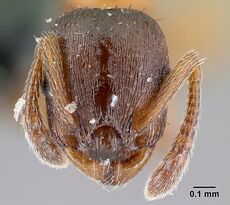Key to Palaearctic Leptothorax and Formicoxenus
This key to workers of Palaearctic Formicoxenus and Leptothorax species is based on Seifert (2023).
Specimens of Leptothorax oceanicus were not available for investigation by Seifert (2023) and he follows the original description of Kuznetsov-Ugamsky (1928) along with the redescription by Radchenko & Heinze (1997). The three socially parasitic Palaearctic Leptothorax species Leptothorax pacis, Leptothorax goesswaldi and Leptothorax kutteri have no workers and not included in this key.
1
- Postpetiolar sternite with a well-developed acute spine (Figs 7, 11, 15). Head very narrow but with a broad frons, FRS/CW > 0.464. Eye small, EYE/CL < 0.176. Genus Formicoxenus => 2
- Postpetiolar sternite in profile without a well developed spine, at most with small frontal denticle (Figs 20, 32). Head wider, frons narrower, eye larger, FRS/CW <0.464, EYE/CL > 0.176. Genus Leptothorax => 4
2
return to couplet #1
- Whole dorsum of head smooth and brilliantly shiny, sometimes frontal lobes and genae weakly longitudinally carinulate. Temperate to boreal zone of Palaearctic from Europe to Russian Far East (Figs 6–9) => Formicoxenus nitidulus
- Whole dorsum of head matt, strongly longitudinally rugulose, the interspaces microreticulate (appearing at lower magnifications punctate) => 3
3
return to couplet #2
- Setae on whole body very short (PnHL/CS < 0.090), widening from base to apex (Fig. 13), apically fringed and in cross-section forming a tridentate star. Frons much broader, FRS/CW >0.533. Middle Asia, Inner Mongolia, Transbaikalia (Figs 10–13) => Formicoxenus sibiricus
- Setae on whole body much longer (PnHL/CS > 0.90), narrowing from base apex (Fig. 17), and in cross-section cylindrical. Frons much narrower, FRS/CW < 0.533. North of Tibetan Plane (Figs 14–17) => Formicoxenus gebaueri
4
return to couplet #1
- Anterior and posterior slopes of petiole node in lateral view almost linear, forming an acute angle and a sharp dorsal corner; subpetiolar lobe broad (Fig. 18). Anteromedian margin of clypeus without a notch. Erect setae on head and mesosoma sparse. Russian Far East => Leptothorax oceanicus
- Dorsum of petiole node in lateral view not forming a sharp, acute corner. Subpetiolar lobe small, dentiform or spiky => 5
5
return to couplet #4
- Scape and tibiae with numerous standing setae (Figs 19–21): Temperate to south arctic zone of whole Palaearctic => Leptothorax acervorum
- Scape and tibiae without standing setae, occasionally semierect pubescence hairs may be present => 6
6
return to couplet #5
- Propodeal spines longer and frons narrower. With all measurements in mm, discriminant 14.66*CW-60.0*FRS+52.06*SPST-7.29 > 2.6 [error 0 % in 6 specimens]. Asia Minor and Caucasus (Figs 22–24) => Leptothorax scamni
- Propodeal spines shorter and frons wider. Discriminant < 2.6 [error 0 % in 90 specimens] => 7
7
return to couplet #6
- Postocular distance smaller, scape relatively longer and head width on average larger. With all measurements in mm, discriminant 37.13*CW+46.90*SL-127.92*PoOc-12.72 > 0.25 [error 0 % in 40 specimens]. Lateral vertex with pronounced longitudinal sculpture, reticular structures in comparison much less obvious. Temperate and submediterranean zone of Europe and Caucasus (Figs 25–27) => Leptothorax gredleri
- Postocular distance larger, scape relatively shorter and head width on average smaller. Discriminant < 0.25 [error 0 % in 50 specimens]. Lateral vertex with a more reticular sculpture => 8
8
return to couplet #7
- Frontal carinae not or only very slightly diverging frontad (FL/FR < 1.025). Petiole relatively lower (PEH/PEL 0.803 ± 0.023) and in profile with a broader dorsal crest. Sculpture weaker. Temperate to south boreal zone of Palaearctic (Figs 28–30) => Leptothorax muscorum
- Frontal carinae notably diverging frontad (FL/FR > 1.025). Petiole relatively higher (PEH/PEL 0.870 ± 0.021) and in profile with a narrow (but not acute) dorsal crest. Sculpture stronger. Tibetan Plane (Figs 31–33) => Leptothorax tibeticum
